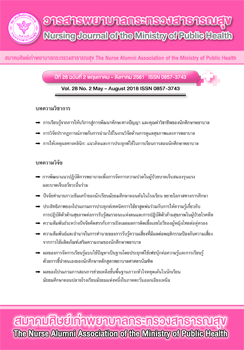Correlation and Predictive Power of Risk Perception affecting Risk Protection Behaviors from Using Cosmetic Products among Nursing Students
Main Article Content
Abstract
Abstract
Nursing students are expected to exhibit correct behavior regarding the use of cosmetic products. This predictive correlational research aimed to study the correlation and predictive power of risk perception affecting risk perception behavior from using cosmetic products of nursing students. The sample consisted of 190 first year to third year nursing students enrolled for academic year of 2017, and recruited by a stratified and systematic sampling method. The instrument was risk perception and risk preventing behaviors from using cosmetic products questionnaire. The content validity of the questionnaire was confirmed by a panel of three experts, yielding a CVI of .80. The reliability of the questionnaire was tested using Alpha-Cronbach Coefficient, revealing value of .71. Data were analyzed using descriptive statistics, Pearson product moment coefficient, and simple regression. The results were found as follows;
1) The risk perception from using cosmetic products was low, and positively associated with the risk prevention behaviors from using cosmetic products at the significance level of .01
(r =.241).
2) The risk perception from using cosmetic products can predict risk prevention behaviors from using cosmetics products at 5.80 % with the significance level of .01.
Thus, nursing students should be encouraged for risk perception from using cosmetic products in order to achieve good behavior to prevent the risk from using cosmetic products.
Article Details
บทความและรายงานวิจัยในวารสารพยาบาลกระทรวงสาธารณสุข เป็นความคิดเห็นของ ผู้เขียน มิใช่ของคณะผู้จัดทำ และมิใช่ความรับผิดชอบของสมาคมศิษย์เก่าพยาบาลกระทรวงสาธารณสุข ซึ่งสามารถนำไปอ้างอิงได้
References
1. Krairiksh P. The Influence of Beauty Bloggers and the Beauty Product Consumption of Thai Women in Online Social Media Era. [Master thesis]. Bangkok: Bangkok University; 2016. (in Thai).
2. Food and Drug Administration. Cosmetic Advertising Guide. Bangkok: Aksorn Graphic and Design Publication; 2015. (in Thai).
3. Uthai Thani Provincial Health Office. The Manual on Consumer Protection, Uthai Thani Province. Uthai Thani: (n.p); 2012. (in Thai).
4. Food and Drug Administration. Action to file a complaint in 2016. [Internet]. 2016[cited 2016 Oct 22]. Available from: http://newsser.fda.moph.go.th/hpsc/frontend/theme/info_operation.php?Submit=Clear. (in Thai).
5. Jaidee J. The Relationships among Female consumers’ Knowedge, Perceived Risk and Buying Behaviors of The skin whitening lotion products. [Master thesis]. Chon Buri: Burapha University; 2015. (in Thai).
6. Becker MH. The health belief model and personal health behavior. Health Education monograph 1974;2(a):409-417.
7. Schiffman LG, Kanuk LL. Cosumer Behavior. 3rd ed. New Jersey: Prentice Hall; 2010.
8. Praphasai P. Perceived risk and perceived product value affecting the purchase decision dietary supplements of consumer in Bangkok. [Master thesis]. Bangkok: Bangkok University;2016. (in Thai).
9. Boromarajonani College of Nursing, Songkhla. Report on the using cosmetic products of nursing students. Songkhla: Author; 2017. (in Thai).
10. Krejcie RV, Morgan DW. Determining sample size for research activities. educational and psychological measurement. University of Minnesota;1970.
11. Kongwong R, Wattananamkul V. A study of “harmful cosmetics” usage behavior among female teenagers in Ubon Ratchathani Province. Isan Journal of Pharmaceutical Sciences 2011;7(1):76-87. (in Thai)
12. Sricharu T. Research and statistical data analysis with SPSSand AMOS. 13th ed. Bangkok: SR Printing; 2012. (in Thai).
13. Cronbach LJ. Essentials of psychological testing. 3rd ed. New York: Harper & Row; 1951.
14. Wiedemann PM, Schutz H. The precautionary principle and risk precreation: experimental studies in the EMF area. Environmental Health Perspectives 2005;113(4):402-5.
15. Hair FJ, Black CW, Babin JB, Anderson ER. Multivariate data analysis. 7th ed. New Jersey: Pearson Education; 2010.
16. Insuwan R. Factors Affecting service behavior of consumers in Bangkok toward Anunline Fitness. [Master thesis]. Bangkok: Srinakharinwirot University;2012. (in Thai).
17. Aphisamacharayothin P. Factors effecting to beauty awareness and unstandardized cosmetic used behaviors of Thai women. Thaksin University Library Journal 2017;6(2):193-216. (in Thai).
18. Pender NJ, Carolyn LM, Parsons MA. Health Promotion in Nursing Practice 5th ed. New Jersey: Pearson Prentice Hall; 2006.
